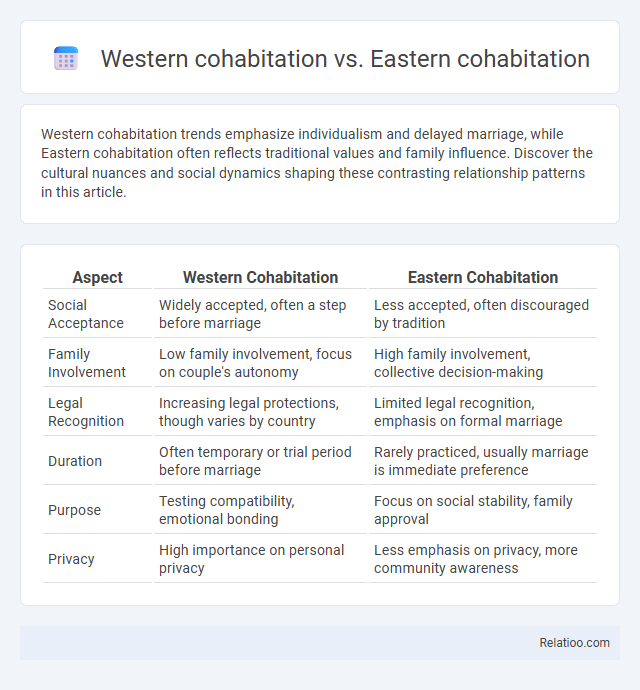Western cohabitation trends emphasize individualism and delayed marriage, while Eastern cohabitation often reflects traditional values and family influence. Discover the cultural nuances and social dynamics shaping these contrasting relationship patterns in this article.
Table of Comparison
| Aspect | Western Cohabitation | Eastern Cohabitation |
|---|---|---|
| Social Acceptance | Widely accepted, often a step before marriage | Less accepted, often discouraged by tradition |
| Family Involvement | Low family involvement, focus on couple's autonomy | High family involvement, collective decision-making |
| Legal Recognition | Increasing legal protections, though varies by country | Limited legal recognition, emphasis on formal marriage |
| Duration | Often temporary or trial period before marriage | Rarely practiced, usually marriage is immediate preference |
| Purpose | Testing compatibility, emotional bonding | Focus on social stability, family approval |
| Privacy | High importance on personal privacy | Less emphasis on privacy, more community awareness |
Introduction to Cohabitation: East vs. West
Cohabitation varies significantly between Western and Eastern cultures due to historical, social, and legal differences influencing relationship norms. Western cohabitation often reflects individualism and increasing acceptance of non-marital partnerships, while Eastern cohabitation tends to emphasize family approval and traditional values. Understanding these cultural distinctions can help you navigate the complexities of cohabitation across regions.
Historical Perspectives on Cohabitation
Western cohabitation historically evolved from strict religious and social norms toward greater acceptance influenced by modernization and secularization, contrasting with Eastern cohabitation where traditional values and collectivist cultures often maintained stricter views until recent urbanization trends prompted gradual shifts. Cohabitation in Western societies became associated with individual freedom and romantic partnerships, whereas in Eastern contexts, family approval and social harmony historically influenced living arrangements. Understanding these differing historical perspectives helps you navigate the cultural complexities and evolving attitudes toward cohabitation globally.
Cultural Attitudes Toward Cohabitation
Cultural attitudes toward cohabitation vary significantly between Western and Eastern societies, reflecting deep-rooted social norms and traditions. In Western countries, cohabitation is widely accepted and often seen as a practical step before marriage or an alternative lifestyle, whereas Eastern cultures tend to uphold traditional family structures, viewing cohabitation outside marriage as socially unacceptable or taboo. Your understanding of these cultural distinctions can help navigate and respect differing perspectives on relationships across global contexts.
Legal Frameworks and Rights of Unmarried Couples
Western cohabitation laws often grant unmarried couples extensive legal rights, including property sharing, inheritance, and child custody, though these vary by state or country. Eastern cohabitation frameworks tend to be more restrictive, frequently lacking formal recognition or legal protections, leaving couples vulnerable in disputes without a marriage contract. Understanding these legal differences is crucial for your relationship security, as rights and obligations in cohabitation depend heavily on regional legislation and cultural contexts.
Social Stigma and Acceptance
Western cohabitation generally experiences higher acceptance with diminishing social stigma, especially among younger generations valuing individualism and personal freedom. Eastern cohabitation often faces stronger social stigma due to cultural norms emphasizing family honor, traditional marriage, and collective values. Cohabitation globally reflects varying degrees of acceptance influenced by religion, legal frameworks, and urbanization, shaping individual choices and societal attitudes.
Family Influence and Expectations
Western cohabitation often reflects individualistic family dynamics where partners prioritize personal choice and autonomy, supported by more liberal societal expectations. Eastern cohabitation generally aligns with collectivist family structures, emphasizing adherence to traditional values and family approval, which can impose stricter social expectations. Cohabitation across cultures is deeply influenced by family roles and expectations, where Western families may accept cohabitation as a step toward marriage, while Eastern families frequently view it as unconventional or inappropriate outside formal matrimony.
Economic Factors Shaping Cohabitation
Western cohabitation is heavily influenced by economic independence and higher living costs, encouraging partners to share expenses without formal marriage. Eastern cohabitation often faces economic pressures tied to traditional family structures and limited housing affordability, leading to more cautious cohabitation practices. In general, economic factors such as income stability, housing prices, and employment opportunities profoundly shape cohabitation patterns across regions.
Cohabitation and Marriage Trends
Cohabitation rates in Western countries have surged, often preceding marriage or replacing it, reflecting shifting social norms and increasing acceptance of non-traditional family structures. In contrast, Eastern cohabitation tends to be less common and more culturally restrained, with marriage remaining the predominant institution despite gradual urbanization and modernization. Global marriage trends show a decline in formal unions, an increase in delayed marriages, and a growing preference for cohabitation, driven by economic factors, changing gender roles, and evolving attitudes toward commitment.
Impact of Religion and Traditions
Western cohabitation often reflects secular values where individualism and romantic partnership prevail, resulting in higher acceptance and legalization of unmarried couples living together. In contrast, Eastern cohabitation is heavily influenced by religious doctrines and traditional norms, such as Hinduism, Islam, and Confucianism, which emphasize marriage as a sacred institution and often discourage premarital cohabitation. The impact of religion and cultural traditions in Eastern societies leads to stricter social stigmatization and legal constraints, whereas Western societies show greater flexibility and evolving family structures.
Cohabitation and Child Rearing Practices
Cohabitation in Western societies often emphasizes individual autonomy and flexibility, with many couples choosing to live together before or instead of marriage, shaping child-rearing practices that prioritize open communication and shared responsibilities between partners. In contrast, Eastern cohabitation tends to be less common and more culturally bound, often influenced by traditional family structures and societal expectations that favor marriage before parenting, leading to child-rearing practices deeply rooted in collective family involvement and hierarchical respect. Understanding these regional differences in cohabitation and child-rearing provides insight into how cultural norms and values directly impact family dynamics and children's developmental environments.

Infographic: Western cohabitation vs Eastern cohabitation
 relatioo.com
relatioo.com